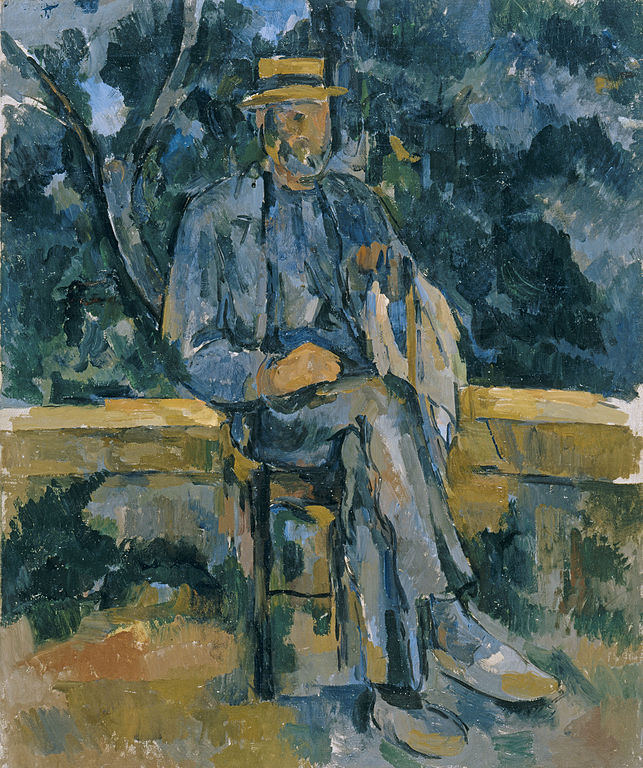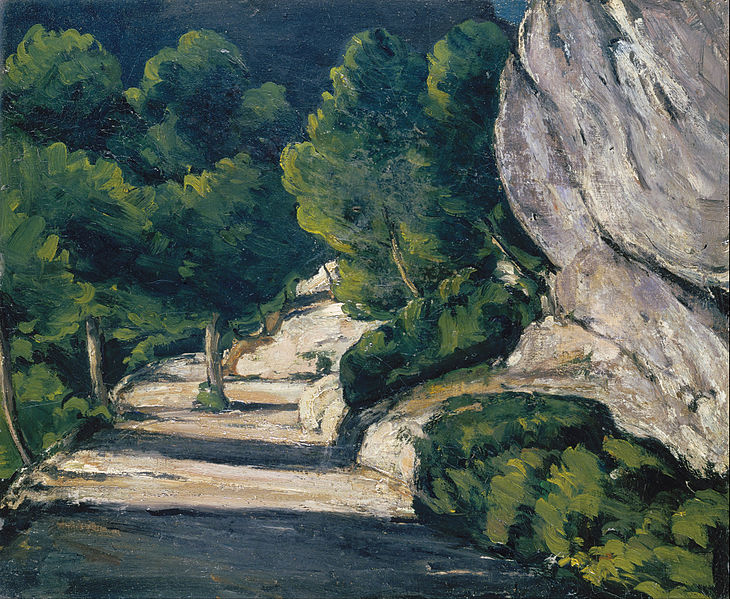The Museo Thyssen is presenting, 4 February to 18 May 2014, the first retrospective on Cézanne to be held in Spain in thirty years, following the one at the MEAC in 1984. The exhibition includes 58 works: 49 oils and 9 watercolours lent by museums and private collections around the world (including the USA, Australia and Japan), many not previously seen in Spain, and 9 works by Pissarro, Gauguin, Bernard, Derain, Braque, Dufy and Lhote.
Born in Aix_en_Provence, Paul Cézanne (1839_1906) was the son of a wealthy hat manufacturer and later banker of whom Cézanne would say, with some irony: “My father was a man of genius; he left me an income of 25,000 francs.” Cézanne was a fellow school pupil of the future writer Émile Zola, with whom he maintained a close and complex friendship for many years. Although Cézanne followed his father’s wishes and embarked on studying law, he soon moved to Paris to follow his true vocation of painting. There he made friends with Pissarro, ten years his senior, who would be the closest to a teacher that he had. He also met Manet and took part in the Impressionists’ informal debates at the Café Guerbois.
Every year from 1863 onwards Cézanne sent his paintings to the official Salon but they were never accepted. In 1874 he took part in the first Impressionist exhibition but would subsequently only exhibit with them once, in 1877. Critics considered him the clumsiest and most eccentric of the group. The negative words employed to describe his painting – brutal, coarse, infantile, primitive – would eventually become terms of praise for the originality of his work.
While his fellow painters, led by Monet and Renoir, would enjoy increasing success, Cézanne, who had abandoned the capital for Aix, would continue to be ignored until 1895. Between November and December of that year his first solo exhibition of around 150 works at Ambroise Vollard’s gallery earned him the respect and admiration of his colleagues and made him a key reference point for young painters. By the time of his death ten years later Cézanne was acknowledged as a key figure in modern art.
The predominant genre in Cézanne’s work is landscape, which accounts for half his total output and which he, like his Impressionist colleagues, identified with the practice of outdoor painting. In contrast to the Impressionists, however, Cézanne also conceded a crucial importance to a genre characteristic of the studio, namely the still life. Throughout his career he produced both landscapes and still lifes, which respectively represent direct contact with nature and the laboratory of composition. The subtitle of this exhibition, site/non_site, derived from the artist and theoretician Robert Smithson, refers to this dialectic between exterior and interior, between outdoor painting and studio work.
Portrait of an unknown man
The first section in the exhibition comprises a single painting,

Portrait of a Peasant
from the Thyssen-Bornemisza Collection, which is the only portrait in the exhibition. It is one of the last canvases that Cézanne worked on before his death. He left the face of the old peasant unpainted, creating a mysterious void. We know that when he lacked a model, Cézanne would sometimes pose before the mirror. Is this in fact an indirect self-portrait of the artist? Portrait of a Peasant is located on the terrace of the artist’s last studio, between the interior and the outdoors. However, this distinction is overcome in the painting. The blue jacket partly fuses with the blue-green vegetation in the garden, as we see in the artist’s views of Mont Sainte-Victoire where mountain and sky interconnect. The borderline between figure and background is thus broken down while the continuity between man and nature is restored.
The bend in the road

Landscape. Road with Trees in Rocky Mountain, 1870_1871. Städel Museum, Frankfurt am Main Bathers, ca.1880. Detroit Institute of Arts. Bequest of Robert H. Tannahill
The exhibition’s second section focuses on roads, particularly on bends and curves. Cézanne was a tireless walker who would go out into the countryside in search of his motifs and who walked around the outskirts of Aix in sun or rain, climbing Mont Sainte_Victoire with his rucksack on his back. The artist hated modern roads, preferring paths that adapted their lines to the landscape, with their changes of viewpoint that created a sense of surprise and expectation. One of his most recurring motifs is the bend in the road, which landscape painters traditionally used to attract the viewer’s gaze into the pictorial space. However in Cézanne’s painting this entry into the painting is frustrated: blocked by some trees and rocks or by the topography itself. Cézanne’s paths go nowhere. Even when the sky is visible in the background it rather seems to resemble a wall.

Avenue at Chantilly, 1888. The Toledo Museum of Art. Gift of Mr. y Mrs. William E. Lewis, 1959;
Nudes and trees
The third section juxtaposes scenes of bathers and landscapes with trees. Within Cézanne’s oeuvre, the paintings of bathers are the only ones that were not painted from life and as such they have always been considered as separate. However, by reinterpreting them in the context of his tree-filled landscapes, particularly those painted at the Jas de Bouffan, the Cézanne family’s country house, they take on another meaning. What if the nudes were just a daydream provoked by the trees?

Hillside in Provence, ca. 1890-1892. National Gallery, London. Bought, Courtauld Fund, 1926;
In the work of Cézanne, trees have an anthropomorphic significance. In his scenes of bathers, trees and nudes combine closely together: a figure hides behind a tree or embraces it or lies back against it; at times the tree seems to emerge from a body. On other occasions the human figure in one painting is replaced in another by a tree, probably inspired by the plant and tree metamorphoses of classical mythology.
The ghost of the Sainte-Victoire
Cézanne’s still lifes are filled with echoes of his landscapes, particularly of Mont Sainte-Victoire, which is the almost obsessive protagonist of his compositions. The painter André Masson said: “Look at these still lifes, they follow the advice of the Sainte-Victoire: they are geological.” In many of Cézanne’s still lifes the tablecloth has hollows in it, bulging out in the form of a mountain and thus evoking the familiar form of the Sainte-Victoire. In

Still Life with Flowers and Fruits, ca.1890. Staatliche Museen zu Berlin, Nationalgalerie
the tension between the large bunch of flowers and the diagonally arranged tablecloth finds its parallel in the dialogue between the pine and the mountain

Mount Sainte-Victoire, ca.1904. Cleveland Museum of Art. Bequest of Leonard C. Hanna, Jr., 1958
In Cézanne’s still lifes, tablecloths and curtains would increasingly cover the top and legs of the table and the studio walls, eventually concealing them completely. They ultimately bury the Cartesian coordinates of the interior space, a symbol of the artist’s rational control, beneath the natural forms of a landscape.

Still Life with Cerries and Peaches, 1885-1887. Los Angeles County Museum of Art. Gift of Adele R. Levy Fund, Inc., and Mr. and Mrs. Armand S. Deutsch.
This section includes four still lifes from the major series on an earthenware pitcher. This unadorned object of no particular style has a unique feature: its rounded belly, a motherform around which things gravitate. Unlike Cézanne’s tablecloths, the earthenware vessel does not resemble the Sainte_Victoire but it is an equivalent to the mountain due to its manner of being a centre.
Play of constructions
Just as Cézanne transformed his still lifes into landscapes, his landscapes without figures or movements can easily become still lifes. It is said that a still life is characterised by its tactile perception. The ideal of tactile perception is a regular, geometrical object. With landscape, Cézanne obtains this effect by making use of architecture.

House in Provence, ca.1881. Indianapolis Museum of Art, Gift of Mrs. James W. Fesler in memory of Daniel W. and Elizabeth C. Marmon The Village of Gardanne, ca.1886. The Brooklyn Museum, Ella C. Woodward Memorial Fund and the Alfred T. White Memorial Fund
which brings to mind Giorgio de Chirico’s words: “The Greek temple is within our grasp; it seems that we can pick it up and take it away with us like a toy on a table.” Cézanne’s landscapes are dotted with red roofs, toy_like houses that function almost as apples arranged on the pieces of cloth in a still life.
While in Cézanne’s still lifes the table becomes concealed by the textiles that simulates a landscape, in his landscapes the artist imposed a structure similar to a tabletop: a vertical foreground, a horizontal plane and another vertical plane in the background. He evolved this stepped construction, which pushes the gaze upwards and towards the background, from the time of his landscapes of L’Estaque up to his views of Gardanne. It would have a decisive influence on the beginnings of Cubism, represented in the exhibition through various works by Braque, Derain, Dufy and Lhote.
More images:
http://www.museothyssen.org/microsites/prensa/2014/cezanne/imagenes.html